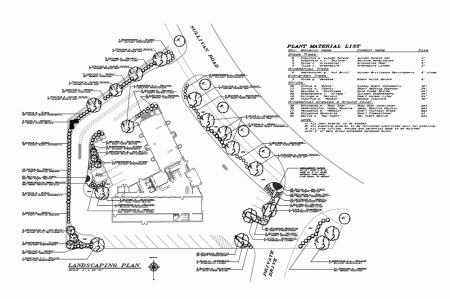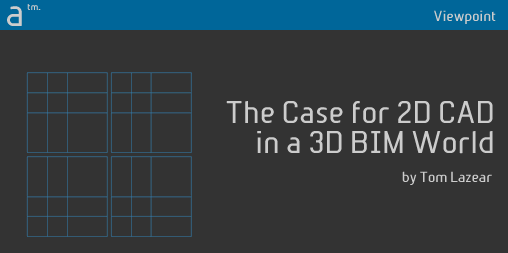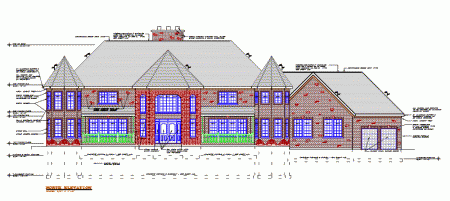If you read the blogs and CAD newsletters, you know that 3D, BIM and other advanced topics fill the air. There is no doubt that these newer technologies will and have already helped improve the productivity of design, However, there is a case to be made that there is still a very strong role for plain old 2D drafting.
First, there are many applications that cannot benefit from 3D, for example, schematics. Secondly, there is a basic tradeoff to be made before jumping into 3D. What types of work does the user do? What are the benefits of 3D for that type of work? And what are the costs to get there and to perform the work in 3D? Let’s look at a few examples:
Store or distribution center layout comes to mind. The store is built and the walls are up. Now it is time for the merchandisers to decide where to put which department, where to locate the display devices, how traffic will flow and the like. This has always been done in 2D for good reason. It is quicker, easier, more suited to the type of people who do the work, and it works! While it might be interesting to be able to “walk through” a 3D model of the store, does that benefit outweigh the cost? Usually not. It is way more important to have a great, accurate library of symbols to be quickly grabbed and placed precisely on the 2D layout.

01 - Tom Lazear would argue that in many cases such as working drawing level documentation for landscape design, there is little value in 3D over 2D CAD.
How about sports complexes? Sagamore Publishers’ classic book, “Facilities Planning for Health, Fitness and Sports,” edited by Thomas Sawyer, is a good example. They include a copy of VersaCAD 2D with each book knowing that 2D is all that is required to layout a new badminton court. Mechanical part and assembly design was one of the earliest applications to go to 3D. And with software like Solid Edge or SolidWorks, 3D is good. However, there are still simpler applications where 2D can do the job just fine, such as parts that are manufactured by 2.5D including flat parts with holes, flat parts with cutouts and more.
Civil always works in what looks like 2D, but is actually backed by 3D models. Architecture has been a favorite target for 3D or BIM software. It just seems logical that a building which is naturally a 3D object should be designed in 3D. And, of course, all buildings are and always have been designed in 3D. The question is whether the design should continue to be in the mind of the architect or on the computer. The next question is how to display the design in a fashion that is easily understood, economically prepared and satisfactory for building from.
There is an argument that , for simpler buildings, experienced architects can move more quickly using their collection of information such as standard details, previous projects, catalogs and the like, than they can putting all of that information into a computer. Here again, there are complex, multi-designer projects where the overhead work of dealing with the computer can pay off large benefits when everyone works off a common 3D model. But that argument does not apply for a number of simpler, smaller architectural projects. Certainly, if industry standards are enforced which requires all buildings must be done in 3D, then the architect has no choice but to adapt or run the risk of not being awarded projects.
So the bottom line is the user needs to make a business decision based on facts and not marketing hype. Here is a short outline on how that analysis might be performed:
Investment Necessary
- Software – from $500 to $5000
- Training – $500 to $3000
- Setup – better plan on a couple of months
- Retraining for turnover – plan for it
- Computer hardware – need bigger
- People – takes different skills than 2D
Benefits to be Derived
- If GSA (or other dictated) – have to do it
- If multi-designer – better coordination
- If owner accepts idea – fewer change-orders
- Earlier – more accurate estimates
- If done right – maybe more satisfied customers
What is above is just an outline. Your own analysis will add detail and other bullet points. When you look closely at what is the true return-on-investment for moving from 2D CAD to 3D CAD/BIM you may be surprised. The point is, to do an honest analysis with no preconceived notions of where you want to arrive. If the rate of return is high, then by all means make the investment to move to a 3D BIM model. If on the other hand the return on investment is not there, then continue to stick with 2D CAD. The benefits of that strategy are typically–again an outline:
- Easier to find capable employees
- Less costly hardware necessary for 2D CAD
- Much less costly 2D CAD software
- Less costly employees
- Think about the project and less about the complex computer software
The bottom line is: there is a case for 2D CAD in a 3D BIM world. While the industry is currently in transition, this means that part of the world benefits more from 2D and part of it benefits more from 3D. You have to evaluate yourself and your business and learn what side best still serves you.
If you do stick with 2D CAD, there are several excellent choices on the Mac (and Windows). If you do stick wtih 2D CAD, VersaCAD for Mac is an excellent choice!
About Viewpoint Articles: Viewpoint articles are features contributed by industry professionals across the entire range of disciplines covered by Architosh. They are aimed at being “instructional” or “position papers” directed at advantages of technologies, configurations, services, or solutions. They are authored by industry professionals who are directors, providers, experts, teachers and thought-leaders within their industry. To inquire about contributing a Viewpoint article please email us at: info@architosh.com






Reader Comments
There may be a place for 2D CAD in a 3D BIM world but not 2D as *part* of a 3D BIM world. For instance I’d hate to see 2D introduced as part of the IFC file format. It doesn’t need to be as software can already display 3D objects in 2D. ArchiCAD’s been doing it for years.
@Christiaan, 2D elements are indeed already part of the IFC file format. I agree that there is a case for 2D as part of a BIM design continuum, but I’m not sure that I fully understand the cast that Tom L. is presenting…
Both of these viewpoints are interesting regarding the IFC format. I’m not sure which one I agree with more (I think the latter). There is a place for 2D in a BIM world but it isn’t the same place for everyone. That is the major thrust of Tom Lazear’s argument. While I may not personally agree with all of this examples, I can think of several others that are valid.
Comments are closed.